1110 Search Results for Core
April 27, 2013
by Robin Parker -
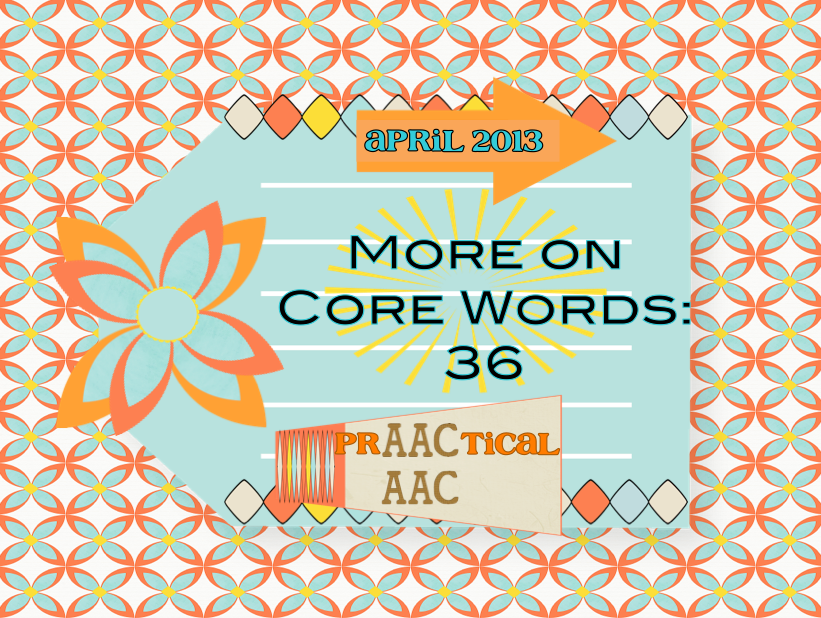
This month we have talked about core words and teaching strategies & considerations for facilitating USING core language. We have talked about aided language input, creating frequent opportunities, making connections b/w symbols and their referents, and motor planning/automaticity. As April ‘goes out’, we add graduated prompting/prompt hierarchies, and wait & signal/time delay prompts. The key to teaching AAC core word language is strategies…. Aided language input (ALI) is fairly simple to do but sometimes overlooked. However, once it becomes habit, it is hard not to do even when you are ‘just’ talking about AAC displays. There are many clinical rationales or reasons why ALI is so important. It provides a model of the language we expect from the child (or adult), and how would anyone speak a language if they never ‘heard’ it. ALI also helps by introducing new words and symbols in meaningful contexts. If we are speaking AAC throughout the day then... [Read More...]
April 26, 2013
by Carole Zangari -
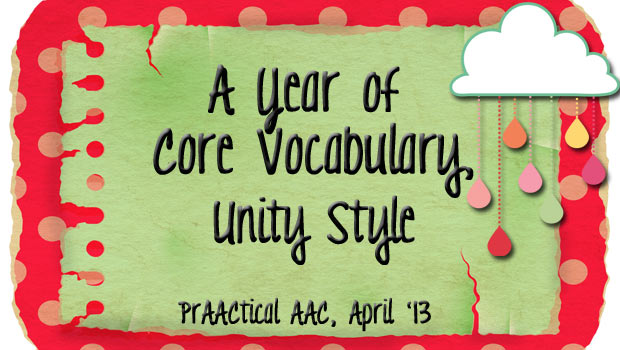
One of the things we most appreciate about the AAC community is the generosity of spirit and sense of collaboration. When we first posted our Year of AAC Core Vocabulary, Gail Van Tatenhove, Russell Cross, and others in the Minspeak community generously shared it with professionals and families. More importantly, they adapted it with Minspeak symbols so that the resource could be more useful to people learning to communicate with that symbol system. We’re excited to be able to share the Year Of AAC Core adapted by Russell Cross. There are two versions: one for people learning 84-location Unity programs and another for people working with the 144-location version. There is one set of cards for each month with about 12 core words each so that professionals can provide extra practice of a selected set of core words. Many, many thanks to Gail and Russell for adapting our work and... [Read More...]
April 22, 2013
by Robin Parker -
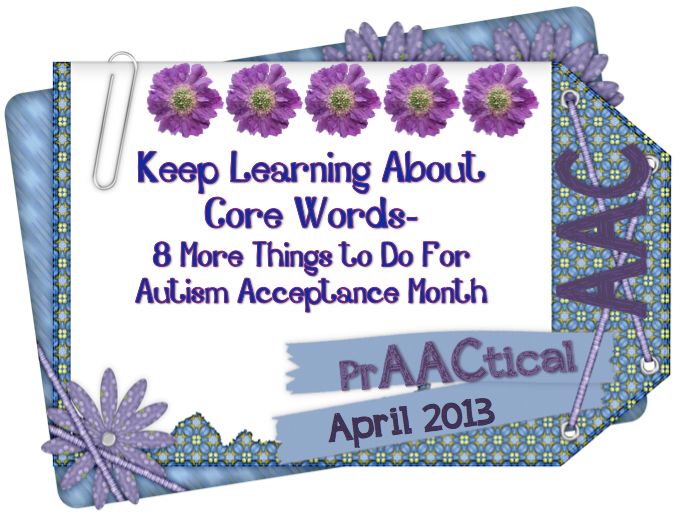
April is Autism Awareness/Acceptance month. It is exciting that there have been so many positive messages and activities around schools, communities, the country, and even the world. It has been great that AAC and visual supports have been incorporated into many educational and communication programs (hopefully soon a ‘tipping point’, so that ALL students who need AAC systems will have them). One of the next ‘tipping points’ that would also be great to see is with the use of core words on communication displays. ‘Core Words’ are our Strategy of the Month and we are writing about the first 12 through the first 36. But, if you want more background information or to go well beyond 36 core words (which is the goal), Here are 8 More Things To Do For Autism Acceptance Month: Take a look at AAC Language Lab for Core Word Information Read ASHA- A Few Good... [Read More...]
April 20, 2013
by Carole Zangari -
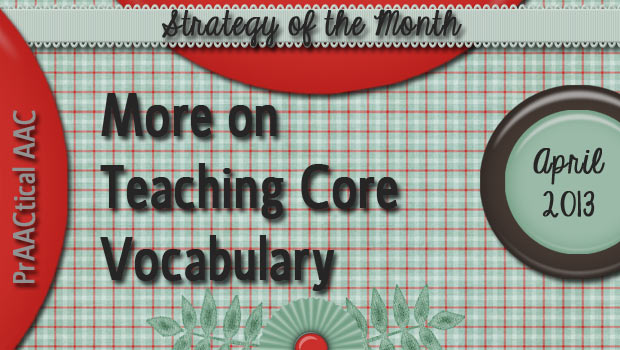
Last week, we talked about two key strategies for teaching core language: using aided language input and creating frequent opportunities to teach and elicit core words. In today’s post, we’ll expand the number of words and discuss two additional considerations for teaching core words. Aided language input is always important in working with beginning users of AAC. It exposes them to their new means of communication, provides them with a competent model of their AAC system, and introduces them to words and symbols they don’t yet know within a meaningful context. It also forces us to slow down when talking, something that can be very beneficial when you consider that many beginning users of AAC also have difficulty processing oral language. (It may take them longer to decode what they’re hearing and they may have to concentrate more than the average kid.) If you’ve actually tried pointing to symbols as... [Read More...]
April 13, 2013
by Robin Parker -
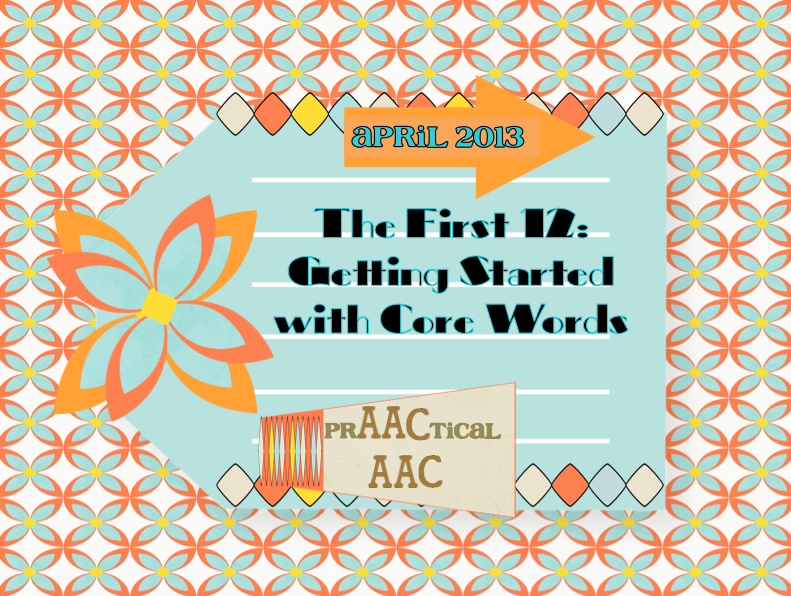
The focus this month is on core word vocabulary and effective teaching strategies. Most core vocabulary is represented through abstract symbols that range from translucent (i.e., makes sense after it is explained) to opaque (i.e., doesn’t have any resemblance to the word or concept) which makes the need for effective teaching all the more important. It also makes it more fun because meaningful language experiences, emotional language experiences, and repetition with variety experiences are going to be the platform for teaching. Within the platform of authentic language experiences, layers of teaching strategies can be applied. The more strategies we apply to learning, the more we assure ALL learners will benefit from our teaching. Core word vocabulary teaching begins with a few premises that underlie the process. These are not new ideas but ones that should be reaffirmed as you begin teaching. It is important, as always, to presume competence. All learners... [Read More...]
April 12, 2013
by Carole Zangari -
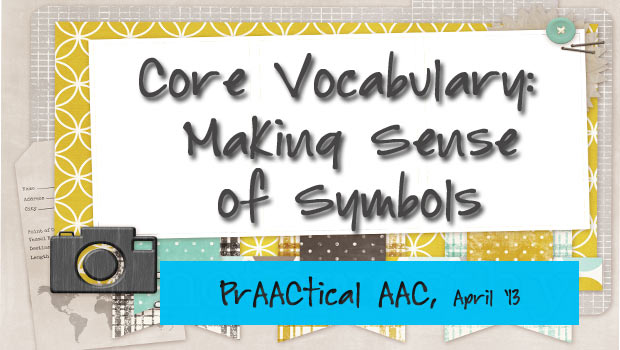
Take a look at these pictures and try to guess their meanings. Now do it again with these symbols. One more time with the symbols below. We’re not gamblers by nature, but if we had to bet we’d say that you had a pretty easy time guessing the first two rows (backpack, banana, bathroom; sleep, wash, eat) and struggled with the last row (know, she, was/were). That presents a bit of a problem, actually, because it’s that last hard-to-guess row that contains important core vocabulary. And these kinds of core words are the ones we need to use frequently during the day. Looks like we have a bit of a dilemma: The symbols that are least transparent are important ones to teach. We often hear SLPs say that they want concrete symbols for some of their clients with AAC needs. We can certainly make that happen for some... [Read More...]
April 8, 2013
by Carole Zangari -
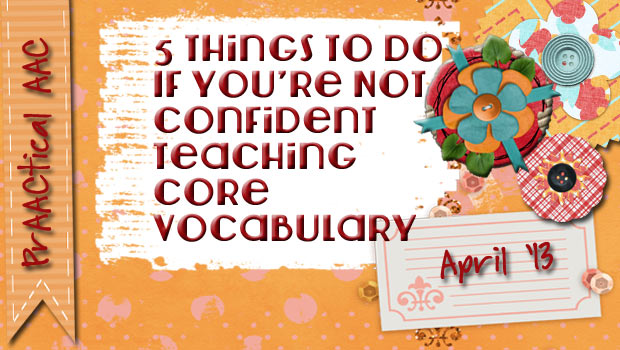
New to teaching core vocabulary in AAC? On board with the concept? Know that it’s important but find it a little intimidating to teach? Welcome to the club! Actually, it’s quite a big club but you wouldn’t know it because lots of members are still closeted. That’s okay – no one here is going to ‘out’ you. But if you want to move forward in your AAC teaching journey, here are some things to try. Breathe and forgive yourself: It’s easy to feel like everyone else knows this but you. Not true. We tend to beat ourselves up for not being out ahead of the curve, but you know what? It’s not worth it. We’re all a work in progress, so let it go and just start where you are. As one of our favorite eminent scholars** has repeatedly said, “When you know better, you do better.” Get your own... [Read More...]
April 6, 2013
by Carole Zangari -

Among the many changes that the AAC field has experienced in the last decade is the notion that core vocabulary is (or should be) an integral part of any AAC system. We grew to understand the limitations of AAC supports that consist primarily of nouns and descriptors, realizing that those kinds of communication displays restricted our clients to requesting and labeling. Our field realized the inadequacy of providing only prestored messages (e.g., limited the client’s ability to communicate anything novel, not flexible enough to meet most communication needs, etc.). In essence, we realized that without core vocabulary, we were imposing a ceiling on language development. We’re thrilled to see so many communication boards, books, SGDs, and AAC apps reflect this knowledge. Having tools with the appropriate vocabulary is a big step in the right direction. But to really shatter the ceiling of language development, we have to be good at... [Read More...]
January 21, 2013
by Robin Parker -
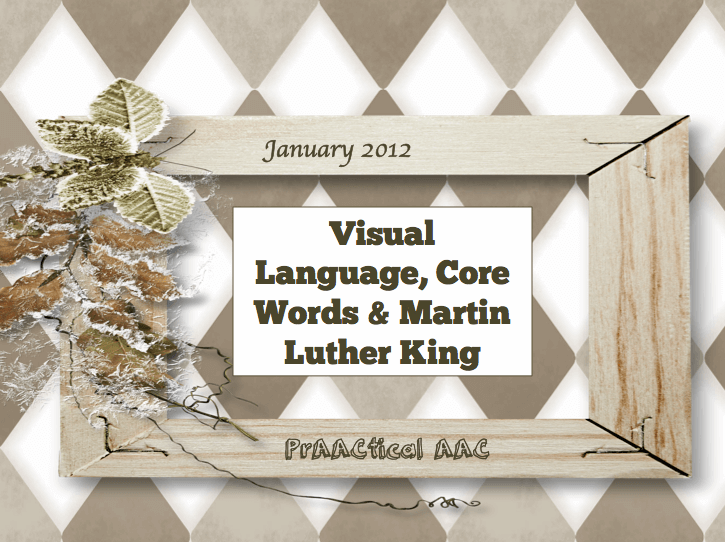
Use a visual format to teach about Martin Luther King. Presume Competence with visual language & AAC teaching. What core words would you use? Check out PrAACtical AAC’s A Year of Core Vocabulary for ideas. THANKS ONLINE COURSES
January 8, 2013
by Carole Zangari -
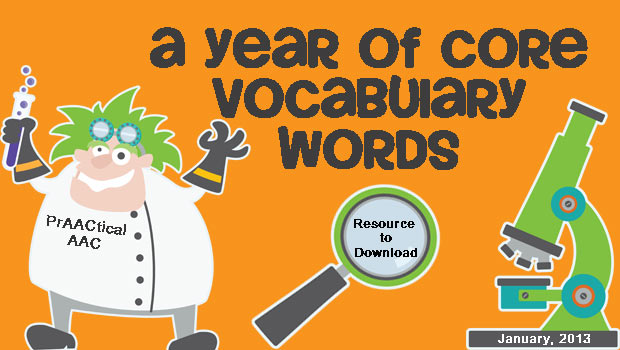
As clinicians, we frequently ask ourselves how we can help AAC learners become fluent with their core vocabulary words. A big part of the answer can be summed up in a word: Focus. The more we focus on those words, the more we can impact learning. There are lots of things competing for our attention, though, and sometimes we get distracted. Then it came to us: Visual supports work for SLP’s, too! When we saw another blogger post visual supports for sight word reading, we knew the idea had prAACtical application. So, we created 12 grids of core vocabulary words – one for each month of the year. Each grid has 12 cells labeled with core words. Plug in the AAC symbols that your client uses (e.g., PCS, SymbolStix, Unity, Pixons, etc), print, laminate, and keep them handy. Feel free to adapt the grids with other core words, if you... [Read More...]









